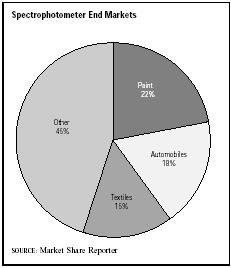SIC 3821
LABORATORY APPARATUS AND FURNITURE
Establishments in this industry are primarily engaged in manufacturing laboratory apparatus and furniture. The main products of this industry include baths and melting point apparatus, laboratory furniture such as furnaces and ovens, component parts and accessories for instruments, and centrifuges.
NAICS Code(s)
339111 (Laboratory Apparatus and Furniture Manufacturing)
The markets for this industry tend to be technologically advanced. The laboratory apparatus and furniture industry is stable domestically, with a small but growing market for international trade, given the global nature of many of its markets. The steady increase has been attributed to growth in exports, and to an increase in medical and scientific research. Other driving forces behind this trend included technology, geographic expansion, and diversification of product range, among others.
Total value of shipments for this industry increased steadily during the late 1990s and early 2000s, rising from $2.33 billion in 1998 to $2.78 billion in 2001. In 2000, when shipment values totaled $2.55 billion, electrical measuring devices accounted for approximately $14.4 million, laboratory instruments accounted for approximately $15.5 million, and measuring instruments accounted for approximately $24.0 million.
The export market for this industry has not been dominated by any one customer, though Canada, Mexico, and Japan have been strong trading partners. Asia was expected to be a major market in the 2000s, due to general increased spending after the depressed markets of the late 1990s, and spending on scientific and medical research in particular.
In the United States, an estimated 369 establishments, employing roughly 20,000 workers, provided laboratory furniture and apparatus manufacturing services in 2001. Establishments generally were small in both size and sales volume when compared to the entire manufacturing industry. Of the companies within the industry, only 8 percent had more than 500 employees. Less than 16 percent employed more than 100 people. Although total number of establishments decreased from 2000 to 2001, employment increased. In fact, employment projections for the medical equipment and supplies manufacturing industry as a whole, of which this industry is a part, were expected to increase annually through 2012.
Sartorius North America Inc. was the industry leader in 2001. The Brentwood, New York-based company had sales of $757 million and 3,600 employees. Fisher Scientific of Pittsburgh had $568 million in sales and 1,800 employees. Third place Kewaunee Scientific Corp. of Statesville, North Carolina, had $85 million in sales and 600 employees.

Research and development (R&D) spending, both by industry and the federal government, drives this market. Spending for medical and scientific research led to an increase in revenue that was expected to continue into the mid-2000s, with demand for efficiency and automation, as well as new product testing, spurring industry growth. In addition, environmental R&D spending was expected to increase.
New apparatus needs, along with a concurrent need to make laboratory costs more efficient, increased several product lines in this industry. Autosamplers, which separate chemicals within a liquid sample, have been in high demand as environmental, pharmaceutical, and biological applications have increased.
For medical labs, I-STAT developed a hand-held blood analyzer that could perform many common blood tests with just a few drops of blood in less than two minutes, keeping labs efficient and reducing the number of resources used to conduct tests. Increased research on new pharmaceuticals and an expanding health care industry worldwide was fueling much of the product development research in the 2000s.
As with most other industries, the laboratory apparatus and furniture industry was continuing to develop products that were automated for efficiency and cost-effectiveness. The effort to control laboratory costs has resulted in numerous product developments that also benefit the environment. For instance, Heto Lab Equipment of Denmark designed several new lines of equipment for laboratory use, including a vacuum pump that re-circulates water, saving up to five tons of water daily.
Further Reading
Baker, Deborah J., ed. Ward's Business Directory of US Private and Public Companies. Detroit, MI: Thomson Gale, 2003.
Darnay, Arsen J., ed. Manufacturing and Distribution USA. Detroit: Thomson Gale, 2003.
Lazich, Robert S., ed. Market Share Reporter. Detroit, MI: Thomson Gale, 2004.
"Making Your Lab Greener." Research and Development , April 1992.
U.S. Census Bureau. Statistics of U.S. Businesses: 2001. 1 March 2004. Available from http://www.census.gov/epcd/susb/2001/us/US332311.htm .
U.S. Department of Commerce. Annual Survey of Manufactures. Washington: GPO, 2002.
U.S. Department of Labor, Bureau of Labor Statistics. Economic and Employment Projections. 11 February 2004. Available from http://www.bls.gov/news.release/ecopro.toc.htm .
US Industry and Trade Outlook. New York: McGraw Hill, 2000.
Comment about this article, ask questions, or add new information about this topic: